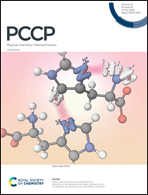Understanding the mechanism and kinetics of the formation and breaking of ring structures during silica polymerization: a computational study†
Abstract
Ring structures are ubiquitous in porous materials and play a crucial role in the functioning of these materials. Understanding the ring formation and breaking mechanism is essential for designing and controlling the porosity, framework density, channels, and cage formation in porous materials. The current work attempts to understand the formation, breaking, and survival of rings using a computational approach. We have used the reaction ensemble Monte Carlo simulation technique and studied silica polymerization starting from monomers to inter-connected large silica clusters in dilute and concentrated silica systems. We calculated various properties of representative smaller and bigger rings at different stages of polymerization. We found that smaller rings form in the initial polymerization stages and larger ring sizes appear at later stages. The smaller rings have a larger residence time than the bigger rings in the silica system, and the residence time changes with the polymerization stage. Both smaller and bigger rings have a shorter residence time in the dilute system than the concentrated silica system. As a result, ring formation and breaking kinetics are faster in the dilute silica system, which causes reorganization within the silica cluster leading to a dense cluster. A slow reorganization of rings in the concentrated silica system is observed, due to which clusters retain their random, branched configuration and porous region within the cluster. We also investigated a series of ring formation and breaking steps to understand the formation mechanism of isolated and grouped rings in the studied silica systems. We found that rings form and break by all possible reactions during ring-formation and cluster-aggregation stages. In contrast, only one reaction is dominant in the initial and aging stages of polymerization. The concentration of silica affects the formation of isolated rings, whereas the kinetics of a grouped ring is not significantly altered. Detailed insights into the reaction dynamics of rings at various stages of polymerization would be helpful in the rational design of porous silica polymorphs.



 Please wait while we load your content...
Please wait while we load your content...